Linked Lists
We already know that Arrays as a data structure exist. Using arrays we can implement a lot of algorithms and we can extend the capabilities of an array in multiple dimensions as well.
Then why do we need another data structure?

There are cases when arrays might not perform in the best way possible. So for handling these use cases we need to introduce more data structures that might help us to overcome problems of arrays.
Problems with arrays:
Arrays consume a contiguous cross-section of memory. Due to this, there can be space issues with the program. So, we know that if we initialise a 10-length array, it will consume 10 consecutive adjacent blocks of memory. But let’s say we don’t have 10 consecutive blocks of memory available but instead 10 blocks are scattered, then arrays will not be helpful as they can’t work with scattered memory blocks.

In an array, we can efficiently (average constant) add a new element or remove an old element to the last of the array. But we don’t have any efficient way to add a new element to the start or remove an old element from the start of the array. The inbuilt functions available in most of the languages which can add or remove an element from the start of the array work in
O(n)time to add/remove a single element.
Linked Lists to the rescue
To overcome the above few disadvantages of the arrays, we introduce a new data structure called Linked Lists.
As the name suggests, Linked Lists → refers to the linkage of different memory blocks leading to a list-like structure. By saying Linked we refer to some kind of a chain-like structure. So just like any ordinary chain structure in Linked List also we have a linkage of memory blocks.
Let’s see how a normal linked List might look like

In a linked list, Node is the fundamental component that stores data. Node is just like any ordinary object (just like a person class we can have objects, similarly objects of a Node class will create linked lists)
A node is an object, that is the fundamental building block of a linked list and multiple nodes linked together to form a linked list. Because it’s an ordinary object we can define a blueprint for it through classes, and using the node class we can create multiple instances of nodes, then connect them and form a linked list.
What properties node will be having?
Because the node is the fundamental block that will store the data, so there should be a data property. Apart from this, we need a mechanism to store the link to the next node. Because linked lists are chains of nodes, so we need a property to establish a chain or a link between two nodes.
We can store the reference to the next chained node object inside the class, let’s call this property next
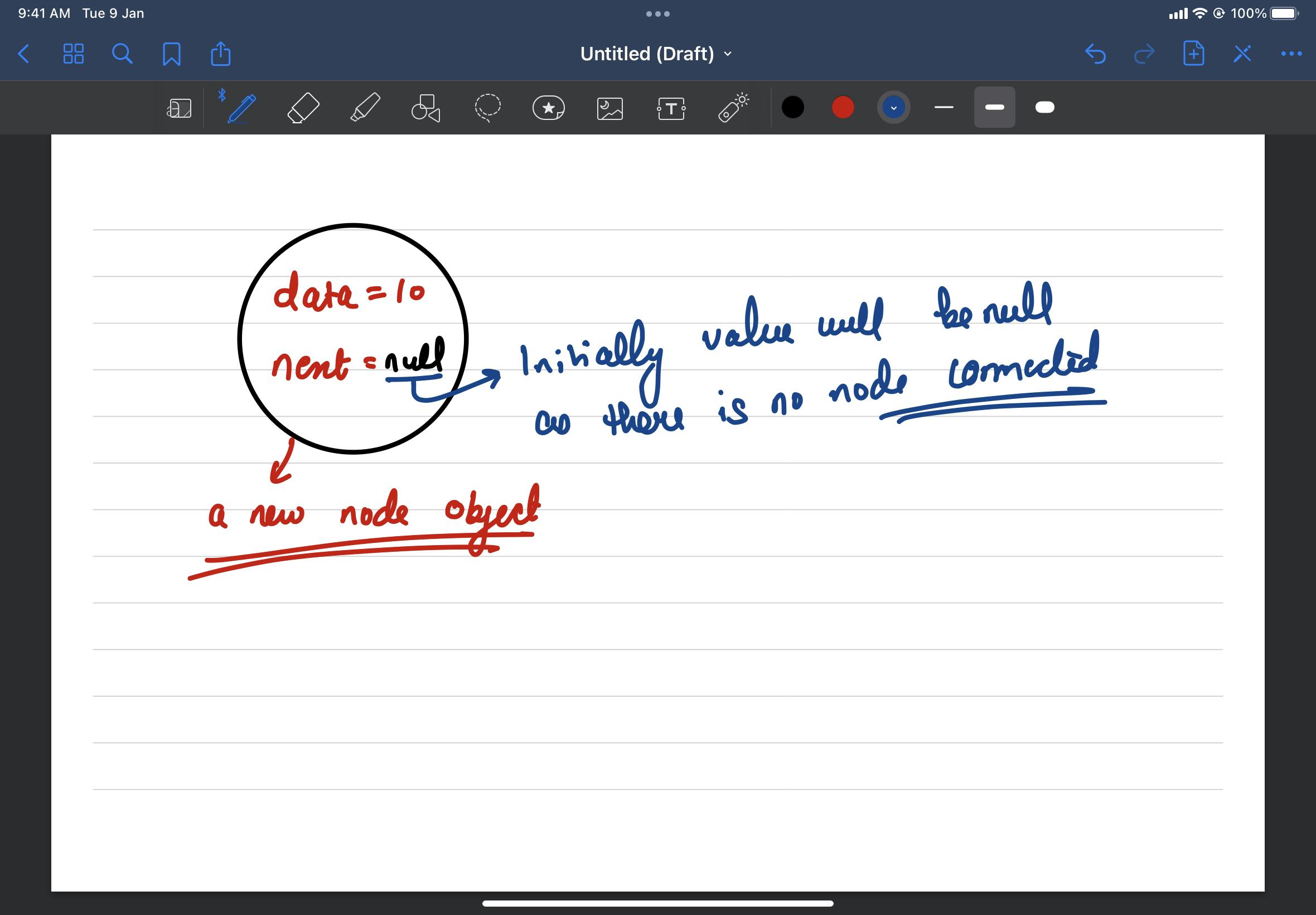
class Node {
constructor(d) {
this.data = d; // data parameter represents the actual data stored in node
this.next = null; // this will be a ref to the next node connected to the curr node
}
}

When we want to connect multiple nodes with each other, we can store the address of the next node in the current node’s next property. So, whenever we say [node.next](node.next)`` We are actually referring to the next node to the current node.
If we want to move from one node to another, we can use this next property to do the same.
How does it help?
So now we know the structure of a linked list that how it looks like, so because we are creating new nodes every time to store new data values, and these nodes are just ordinary objects created as instances of Node class, will be always created at some random available memory location. So, no more restriction of contiguous memory requirement.
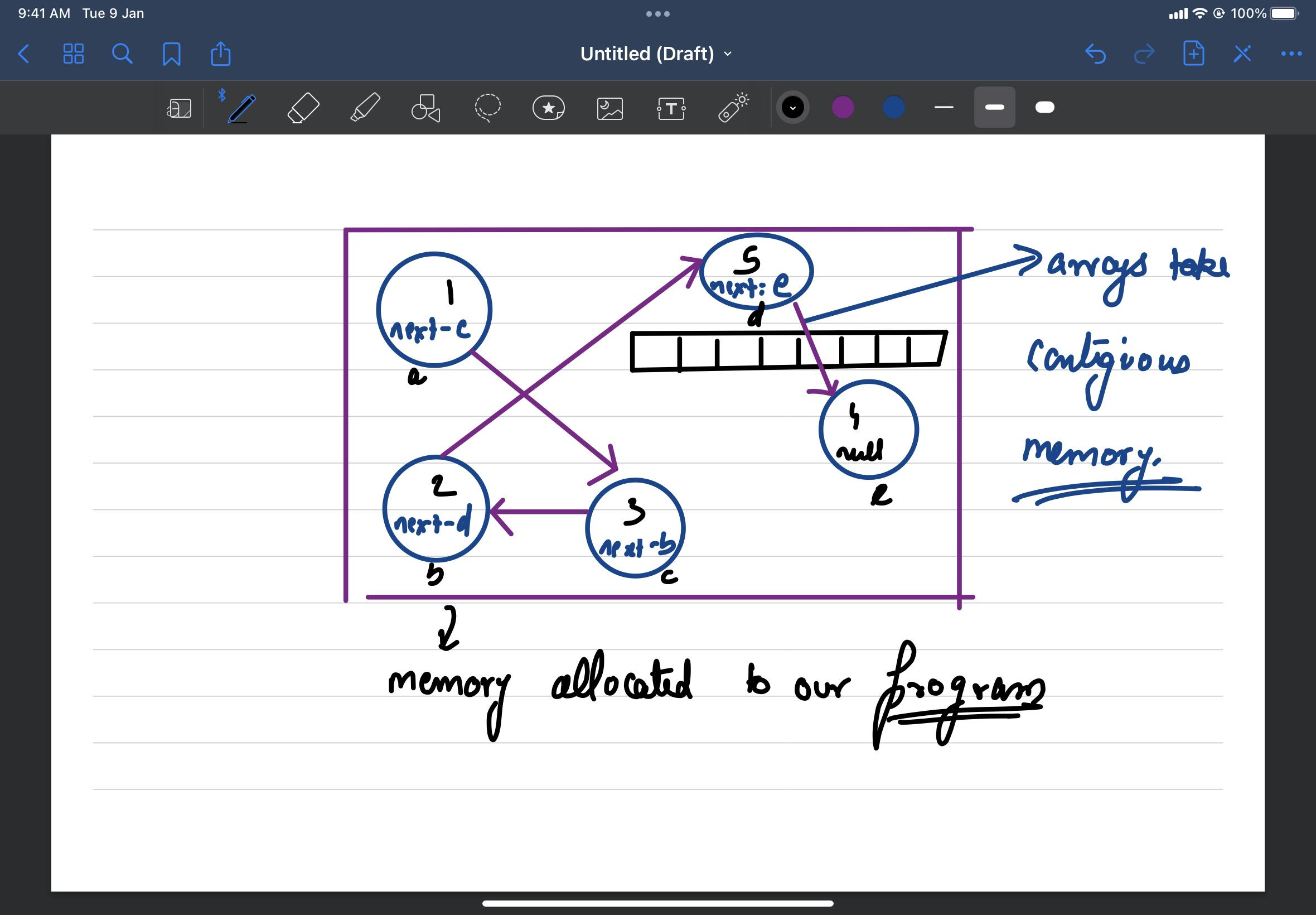
So this is going to help us in optimal usage of the memory space available. For example, if we have enough memory to store 10 data values but not in contiguous locations, instead the memory might be scattered so in this case Linked Lists will be very helpful because every node of a linked list is created at a random available memory location as it is just an ordinary object hence it does optimal and sensible usage of memory.
The advantage of addition of a node at the start
So in arrays, the addition or deletion of a data point from starting was in-efficient because, arrays have strict space constraints, so we need to shift all the values forward / backwards for doing addition/removal of data.
But this is not the case with Linked List, because every node is created at a new memory location, we don’t need to do the shiftings. All we have to do is create a new node and store the reference of the previously available first node to the next property of the current node.
Head and Tail of Linked List
The first node of a Linked List which is accessible to us, is called as The head of the linked list and the last node after which no other node is connected are called as the The tail of the linked list.

Types of Linked Lists
There are multiple different types of Linked Lists available
Singly Linked List: In a singly linked list there is only one direction of the chain. We can move from head to the next node then to the next node and so on till the node, i.e. from any current node we have access to the next node only, so we can only move forward and we cannot come backwards, i.e. there is no way to come to the previous node of the linked lists. The above images are examples of singly linked lists.
Doubly Linked List: In a doubly linked list there are two directions of the chain. We can move from the head to the next node then to the next node and even come back to the previous node. So for doubly linked list inside the node class, we have one more property apart from data and next called
prev. This prev property stores reference to the previous node.
Circular Linked List: In a circular linked list, tail is connected to the head, so there is no node with next as null.
Skip lists: In a skip list, one node is not only connected to the next node but there will be some connection to a few later available nodes as well.
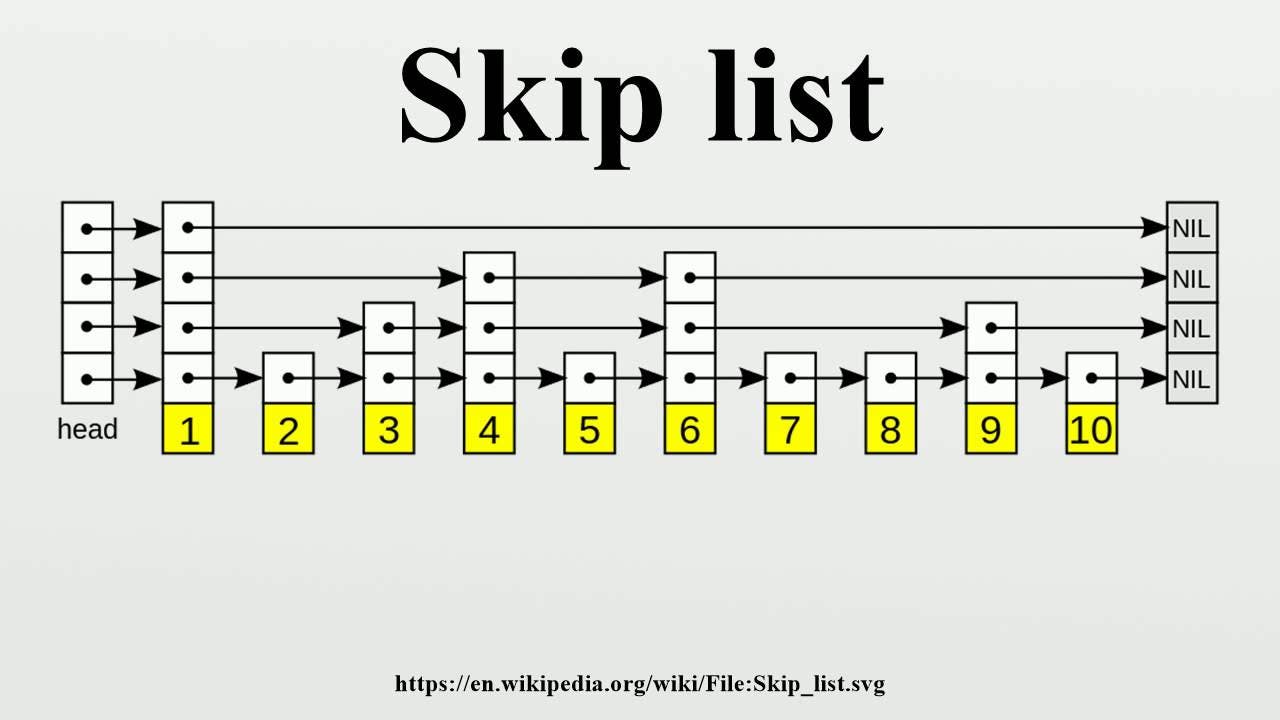
Implementation of Linked Lists
For implementing Linked Lists we need to write the following operations:
AddAtHead (addition of a node at head)
AddAtTail (addition of a node at the tail)
AddAt (addition of a node in between)
RemoveHead
RemoveTail
RemoveAt (remove a particular node in between)
Display
These functions we need to implement for implementing a linked list.
Linked List Class
In most the situation while operating on a linked list we will be having access to the head only. And initially when we have not attached any node to the linked list head will be null.
class LinkedList {
constructor() {
// when we initialise a new linked list head will be empty
this.head = null;
}
}
Addition of Node at the head of a Linked List
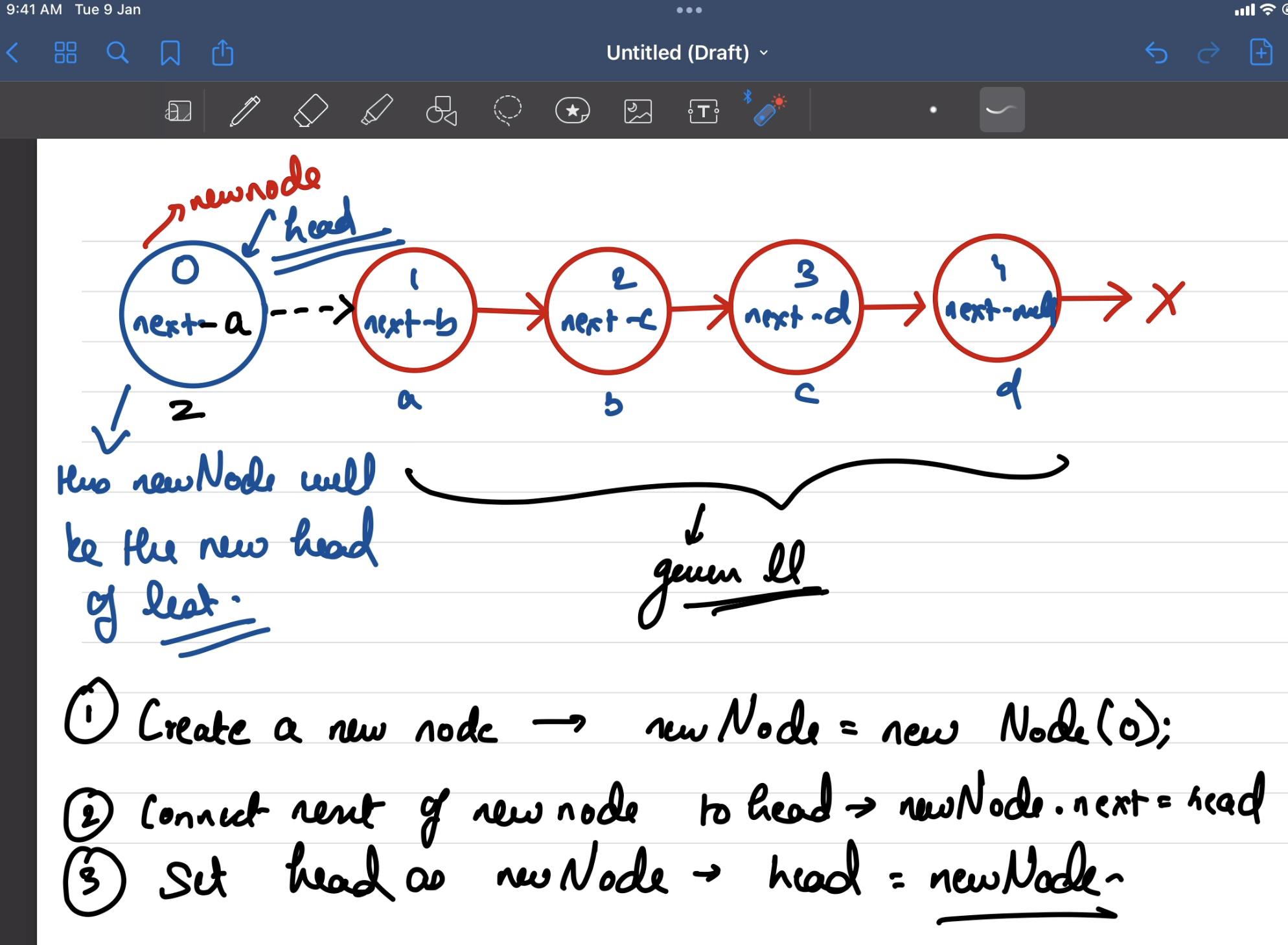
To add a new node to the head of a linked list,
we will first create a new node object, this object will be having next property as null.
set the next property of the new node object to the previous head
update the head of the linked list to be equal to the new node object
Time complexity will be O(1) as we are just creating an object and then manipulating pointers and constant space because no other data structure is used
class Node {
constructor(d) {
this.data = d; // data parameter represents the actual data stored in node
this.next = null; // this will be a ref to the next node connected to the curr node
}
}
class LinkedList {
// singly
constructor() {
// when we initialise a new linked list head will be empty
this.head = null;
}
addAtHead(data) {
let newNode = new Node(data); // created a new node
newNode.next = this.head; // set the next of new node to head
this.head = newNode; // update the head to the new node
}
display() {
console.log(this.head);
}
}
let ll = new LinkedList();
ll.addAtHead(5);
ll.addAtHead(4);
ll.addAtHead(3);
ll.addAtHead(2);
ll.addAtHead(1);
ll.display();
Removing an element from the head of the list:
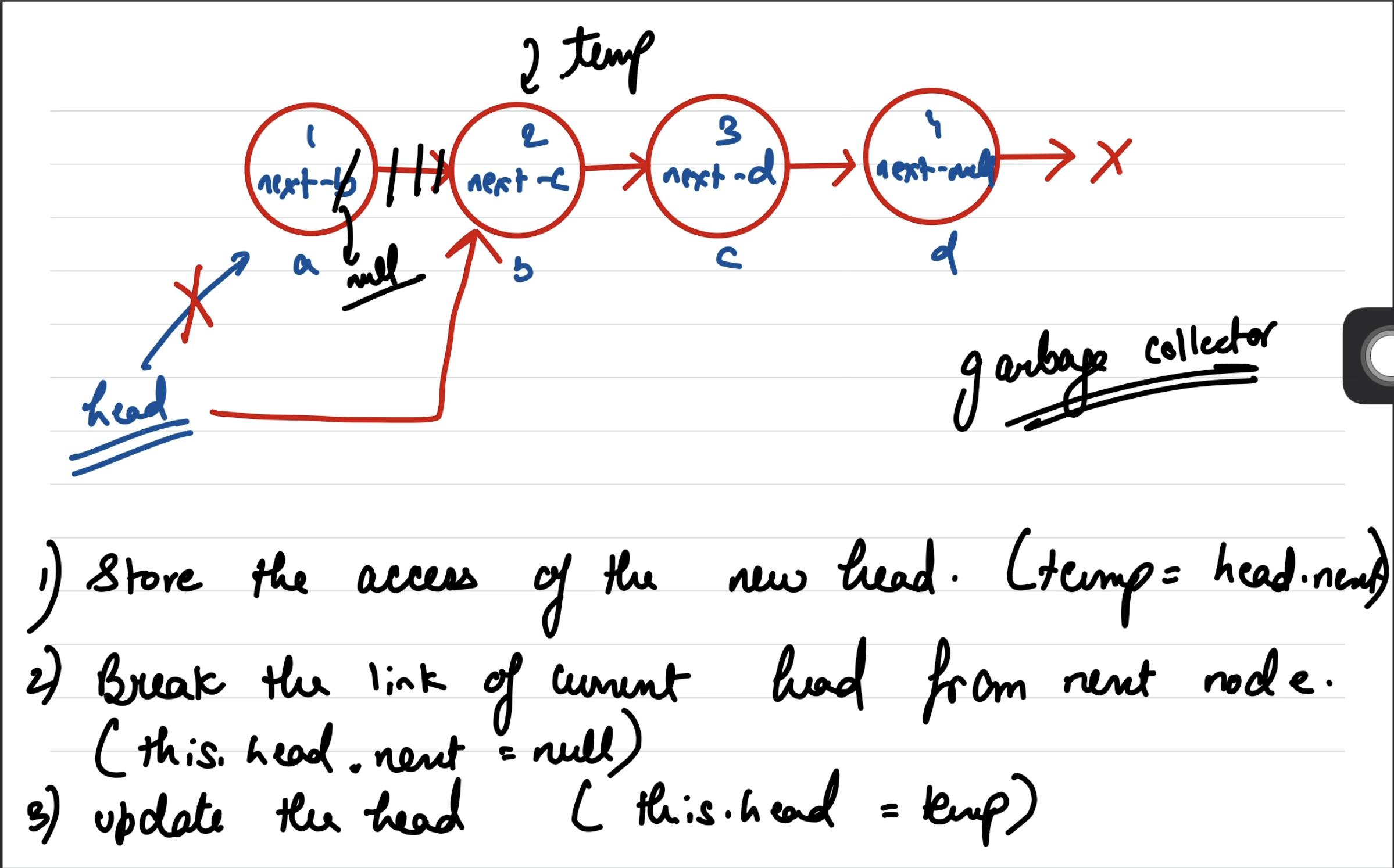
First store access of the node that will become the next head.
Break the link of the current head from the remaining list
and update the head
Time complexity will be O(1) as we are just manipulating pointers and constant space because no other data structure is used
class Node {
constructor(d) {
this.data = d; // data parameter represents the actual data stored in node
this.next = null; // this will be a ref to the next node connected to the curr node
}
}
class LinkedList {
// singly
constructor() {
// when we initialise a new linked list head will be empty
this.head = null;
}
addAtHead(data) {
let newNode = new Node(data); // created a new node
newNode.next = this.head; // set the next of new node to head
this.head = newNode; // update the head to the new node
}
removeAtHead() {
if(this.head == null) return;
let temp = this.head.next; // stored access to new head
this.head.next = null; // de linked the old head
this.head = temp; // updated the head
}
display() {
console.log(this.head);
}
}
let ll = new LinkedList();
ll.addAtHead(5);
ll.addAtHead(4);
ll.addAtHead(3);
ll.addAtHead(2);
ll.addAtHead(1);
ll.display();
Print the list
If we want to print the data of the nodes of the list, We should now move the head anywhere, as it can lead to loss of access to the current head if we are not careful. Instead prepare a temp variable starting from the head, and till the tile temp is not null keep on printing the temp variable and move the temp to the next node.

class Node {
constructor(d) {
this.data = d; // data parameter represents the actual data stored in node
this.next = null; // this will be a ref to the next node connected to the curr node
}
}
class LinkedList {
// singly
constructor() {
// when we initialise a new linked list head will be empty
this.head = null;
}
addAtHead(data) {
let newNode = new Node(data); // created a new node
newNode.next = this.head; // set the next of new node to head
this.head = newNode; // update the head to the new node
}
removeAtHead() {
if(this.head == null) return;
let temp = this.head.next; // stored access to new head
this.head.next = null; // de linked the old head
this.head = temp; // updated the head
}
display() {
let temp = this.head;
while(temp != null) {
console.log(temp.data);
temp = temp.next;
}
}
}
let ll = new LinkedList();
ll.addAtHead(5);
ll.addAtHead(4);
ll.addAtHead(3);
ll.addAtHead(2);
ll.addAtHead(1);
ll.display();
If we change the while condition to [temp.next](temp.next)` ≠ null`, then the loop will stop at the tail, and won’t print the tail.
Adding a new node at the tail
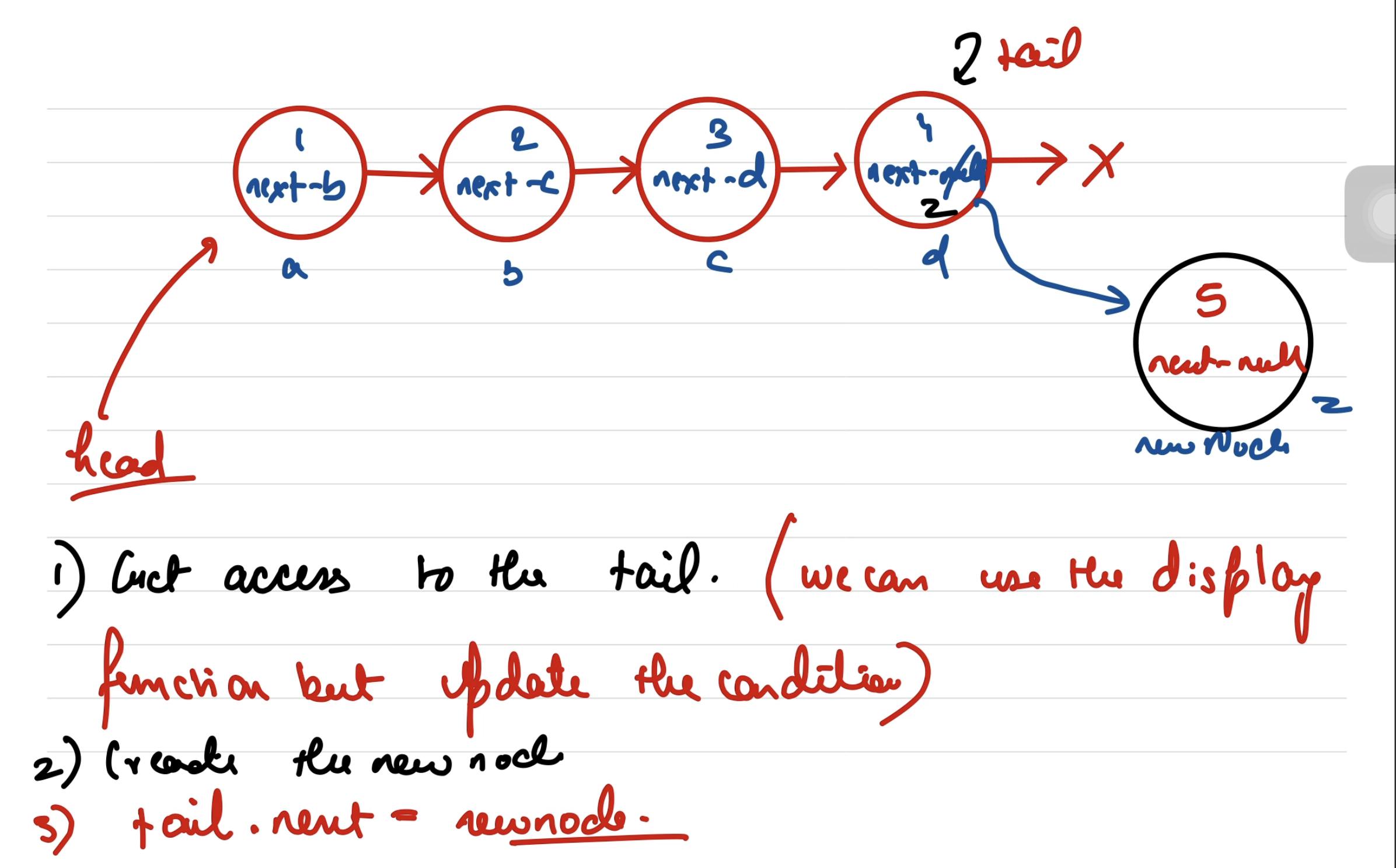
We can just iterate to the tail of the linked list. To do that, we can use the display function’s idea with an updated condition that is temp.next != null so that we stop the iteration at the tail.
Then we create the new node and attach the next of the tail on the new node.
Time complexity will be O(n) because we have to iterate over all the n nodes to get access to the tail and space will be constant as no other data structure is used
class Node {
constructor(d) {
this.data = d; // data parameter represents the actual data stored in node
this.next = null; // this will be a ref to the next node connected to the curr node
}
}
class LinkedList {
// singly
constructor() {
// when we initialise a new linked list head will be empty
this.head = null;
}
addAtHead(data) {
let newNode = new Node(data); // created a new node
newNode.next = this.head; // set the next of new node to head
this.head = newNode; // update the head to the new node
}
removeAtHead() {
if(this.head == null) return;
let temp = this.head.next; // stored access to new head
this.head.next = null; // de linked the old head
this.head = temp; // updated the head
}
addAtTail(data) {
if(this.head == null) { // if ll is empty, addattail is equal to addathead
this.addAtHead(data);
return;
}
let tail = this.head;
while(tail.next != null) tail = tail.next;
let newNode = new Node(data);
tail.next = newNode;
}
display() {
let temp = this.head;
while(temp != null) {
console.log(temp.data);
temp = temp.next;
}
}
}
let ll = new LinkedList();
ll.addAtHead(5);
ll.addAtHead(4);
ll.addAtHead(3);
ll.addAtHead(2);
ll.addAtHead(1);
ll.display();
Remove the node at the tail
To delete the tail node, we need access to the second last node of the list, and mark its next reference as null.
Time complexity will be O(n) because we have to iterate over all the n nodes to get access to the tail and space will be constant as no other data structure is used
class Node {
constructor(d) {
this.data = d; // data parameter represents the actual data stored in node
this.next = null; // this will be a ref to the next node connected to the curr node
}
}
class LinkedList {
// singly
constructor() {
// when we initialise a new linked list head will be empty
this.head = null;
}
addAtHead(data) {
let newNode = new Node(data); // created a new node
newNode.next = this.head; // set the next of new node to head
this.head = newNode; // update the head to the new node
}
removeAtHead() {
if(this.head == null) return;
let temp = this.head.next; // stored access to new head
this.head.next = null; // de linked the old head
this.head = temp; // updated the head
}
addAtTail(data) {
if(this.head == null) { // if ll is empty, addattail is equal to addathead
this.addAtHead(data);
return;
}
let tail = this.head;
while(tail.next != null) tail = tail.next;
let newNode = new Node(data);
tail.next = newNode;
}
removeAtAtail() {
if(this.head == null) return; // empty ll
if(this.head.next == null) { // only one node in the list
this.head = null;
return;
}
let temp = this.head;
while(temp.next.next != null) {
// the above condition gives us access to second last node
temp = temp.next;
}
temp.next = null;
}
display() {
let temp = this.head;
while(temp != null) {
console.log(temp.data);
temp = temp.next;
}
}
}
let ll = new LinkedList();
ll.addAtHead(5);
ll.addAtHead(4);
ll.addAtHead(3);
ll.addAtHead(2);
ll.addAtHead(1);
ll.display();
Add at a position x in the LL
To get access to position x of the LL, we need to iterate x times on the LL and maintain a pointer temp, that can help us to reach there. While iterating we need to keep a check also that we have not crossed the tail of the LL in case if the position of greater than the length of the list.
The moment we have access to the position x’s node, we can create a new node, and then mark the next of the new node to the next of the xth node, and then update the xth node’s next with the new node.
Time complexity will be O(n) because we might have to iterate over all the n nodes and space will be constant as no other data structure is used

class Node {
constructor(d) {
this.data = d; // data parameter represents the actual data stored in node
this.next = null; // this will be a ref to the next node connected to the curr node
}
}
class LinkedList {
// singly
constructor() {
// when we initialise a new linked list head will be empty
this.head = null;
}
addAtHead(data) {
let newNode = new Node(data); // created a new node
newNode.next = this.head; // set the next of new node to head
this.head = newNode; // update the head to the new node
}
removeAtHead() {
if(this.head == null) return;
let temp = this.head.next; // stored access to new head
this.head.next = null; // de linked the old head
this.head = temp; // updated the head
}
addAtTail(data) {
if(this.head == null) { // if ll is empty, addattail is equal to addathead
this.addAtHead(data);
return;
}
let tail = this.head;
while(tail.next != null) tail = tail.next;
let newNode = new Node(data);
tail.next = newNode;
}
removeAtAtail() {
if(this.head == null) return; // empty ll
if(this.head.next == null) { // only one node in the list
this.head = null;
return;
}
let temp = this.head;
while(temp.next.next != null) {
// the above condition gives us access to second last node
temp = temp.next;
}
temp.next = null;
}
addAt(pos, data) {
if(this.head == null) {
this.addAtHead(data);
return;
}
let temp = this.head;
for(let i = 0; i < pos && temp.next != null; i++) {
temp = temp.next;
}
// now inside temp we have access to the node at pos
let newNode = new Node(data);
newNode.next = temp.next;
temp.next = newNode;
}
display() {
let temp = this.head;
while(temp != null) {
console.log(temp.data);
temp = temp.next;
}
}
}
let ll = new LinkedList();
ll.addAtHead(5);
ll.addAtHead(4);
ll.addAtHead(3);
ll.addAtHead(2);
ll.addAtHead(1);
ll.display();
remove at a given position
If we want to remove a node at a particular position, we need to make sure that we have access to the node present in the previous position i.e. pos-1
The moment we have access to the prev node, then [prev.next](prev.next)`` is the node to be deleted.
We can mark the [prev.next](prev.next)`asnodeToBeDeletedand then mark the next of prev node i.e. [prev.next](http://prev.next) equal to [nodeToBeDeleted.next`](nodeToBeDeleted.next)
And then to isolate the node to be deleted we can do nodeToBeDeleted.next = null
Time complexity will be O(n) because we might have to iterate over all the n nodes and space will be constant as no other data structure is used
class Node {
constructor(d) {
this.data = d; // data parameter represents the actual data stored in node
this.next = null; // this will be a ref to the next node connected to the curr node
}
}
class LinkedList {
// singly
constructor() {
// when we initialise a new linked list head will be empty
this.head = null;
}
addAtHead(data) {
let newNode = new Node(data); // created a new node
newNode.next = this.head; // set the next of new node to head
this.head = newNode; // update the head to the new node
}
removeAtHead() {
if(this.head == null) return;
let temp = this.head.next; // stored access to new head
this.head.next = null; // de linked the old head
this.head = temp; // updated the head
}
addAtTail(data) {
if(this.head == null) { // if ll is empty, addattail is equal to addathead
this.addAtHead(data);
return;
}
let tail = this.head;
while(tail.next != null) tail = tail.next;
let newNode = new Node(data);
tail.next = newNode;
}
removeAtAtail() {
if(this.head == null) return; // empty ll
if(this.head.next == null) { // only one node in the list
this.head = null;
return;
}
let temp = this.head;
while(temp.next.next != null) {
// the above condition gives us access to second last node
temp = temp.next;
}
temp.next = null;
}
addAt(pos, data) {
if(this.head == null) {
this.addAtHead(data);
return;
}
let temp = this.head;
for(let i = 0; i < pos && temp.next != null; i++) {
temp = temp.next;
}
// now inside temp we have access to the node at pos
let newNode = new Node(data);
newNode.next = temp.next;
temp.next = newNode;
}
removeAt(pos) {
if(this.head == null) return; // LL was empty
if(this.head.next == null || pos == 0) {
// either you have a single node or pos is 0
this.removeAtHead();
return;
}
let prev = this.head;
for(let i = 0; i < pos - 1; i++) {
prev = prev.next;
}
let nodeToBeDeleted = prev.next;
prev.next = nodeToBeDeleted.next;
nodeTobeDeleted.next = null;
}
display() {
let temp = this.head;
while(temp != null) {
console.log(temp.data);
temp = temp.next;
}
}
}
let ll = new LinkedList();
ll.addAtHead(5);
ll.addAtHead(4);
ll.addAtHead(3);
ll.addAtHead(2);
ll.addAtHead(1);
ll.display();
And that's a wrap, we successfully created a new linked list in Javascript. Do drop your suggestions in the comments below what more topics you would love to read?
.
.
.
.
Lukewarm regards
Sanket Singh

